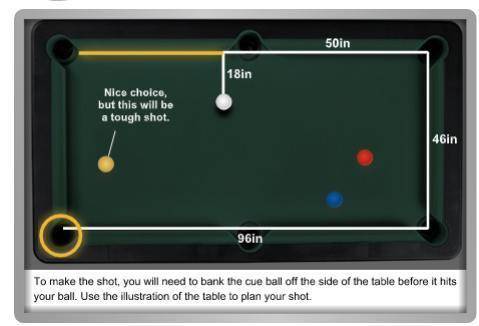
Mathematics, 12.12.2021 22:30 gisellekatherine1
WILL GIVE POINTS
Setting Up for the Shot.
You're playing a game of pool and it's your turn, but you have no direct shots. To make any shot, you will need to bank the cue ball (the white ball) off the side of the table before it hits your ball. That means that you hit the cue ball so that it bounces off the side and then hits your colored ball, moving it in the direction of a pocket (hole). The angle that the ball hits the bumper is equal to the angle that it bounces off the bumper.
The cue ball is 18 inches from the top bumper (side of pool table) and 50 inches from the right bumper. The dimensions of the pool table are 96 inches in the horizontal direction by 46 inches in the vertical direction. Use the illustration of the table and what you know about similar triangles to plan your shot.
1. Which ball did you select? Red, yellow, or blue? (1 point: 1 point for selection)
2. Construct a triangle by performing each of these steps. (6 points: 1 point for each step)
a. Label the cue (white) ball A.
b. Identify the pocket (hole) that you want your ball to go in. Label the center of this pocket E.
(Hint: Click on the ball in the image on the Pool Table Problem page to see how to make this shot.)
c. Draw a line segment that starts at E, goes through the colored ball, and ends at the other side of the table. Label the other endpoint of the segment C.
d. Draw a line segment from C to A (the cue ball). This segment will make the same angle with the bumper as CE.
e. Draw a perpendicular line segment from A to the same bumper (side of table) C is on. Label the endpoint B.
f. Complete triangle ABC by drawing the line segment BC.
3. Complete triangle CDE that is similar to ABC. Where does D need to be to create a similar triangle? Label vertex D and mark the angles that have the same measure. (2 points)
4. Assign a variable to name the length of BC and label it on your figure. To identify the lengths of AB, CD, and DE, use the dimensions of the pool table. Some lengths will include a variable. (4 points: 1 point for each label)
5. Use your similar triangles to set up a proportion. Solve this proportion for the unknown variable, the length of BC. (5 points: 2 points for the proportion, 3 points for the work.
6. To make your shot, you need the cue ball to hit point C. Find length CD and use it to identify the location of C in relation to one of the corner pockets. For example, if C is on the upper bumper, your answer might be: 15 inches to the right of the upper left pocket. Round your answer to the nearest inch. (2 points: 1 point for distance, 1 point for location)


Answers: 1


Other questions on the subject: Mathematics

Mathematics, 21.06.2019 17:00, samantha9430
The magnitude, m, of an earthquake is defined to be m=log l/s, where i is the intensity of the earthquake (measured by the amplitude of the seismograph wave) and s is the intensity of a “standard” earthquake, which is barely detectable. what is the magnitude of an earthquake that is 1,000 times more intense than a standard earthquake? use a calculator. round your answer to the nearest tenth.
Answers: 1


Mathematics, 21.06.2019 19:00, breannaasmith1122
Which of the expressions (on the photo document i inserted) together represent all solutions to the following equation? 8cos(12x)+4=-4 *the answer should be in degrees.* > i would like for someone to explain the process to find the solutions for this.
Answers: 2
You know the right answer?
WILL GIVE POINTS
Setting Up for the Shot.
You're playing a game of pool and it's your turn,...
You're playing a game of pool and it's your turn,...
Questions in other subjects:

Chemistry, 18.01.2021 21:30




Health, 18.01.2021 21:30


Biology, 18.01.2021 21:30


Mathematics, 18.01.2021 21:30

English, 18.01.2021 21:30



